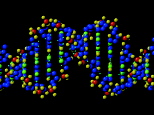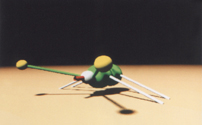A magazine where the digital world meets the real world.
On the web
- Home
- Browse by date
- Browse by topic
- Enter the maze
- Follow our blog
- Follow us on Twitter
- Resources for teachers
- Subscribe
In print
What is cs4fn?
- About us
- Contact us
- Partners
- Privacy and cookies
- Copyright and contributions
- Links to other fun sites
- Complete our questionnaire, give us feedback
Search:
It's Life Jim, but not as we know it
Pop down to your chemist and buy some oxygen, carbon, hydrogen, nitrogen, calcium, and phosphorus. OK, now put it all together to make a human being. What's the problem? All the necessary chemicals you need are there. It's just a question of knowing how you put them together.
What do we mean by life?

Life as we know it comes from the right combinations of chemicals, but what do we mean by life? It may seem odd that computer scientists ask this question; surely it's a question for biologists or philosophers? Well, computer scientists can be both, and in the fascinating field of artificial life (A-life) they explore these very questions.
Artificial life asks questions about how 'life as we know' it and - possibly more interestingly - 'life as it could be' come about. Through writing computer programs or building robots to simulate (to try and duplicate or model) real living biological systems we can start to try and understand how our biology works. We can also model the process of evolution in computers, so that we can build our own alien worlds and populate them with our own creatures, and see how they change and adapt to survive. We could, for example, throw in asteroid strikes to change the climate and see what happens next.
Some A-life computer scientists work in the field of xenobiology, trying to work out how aliens on distant planets might look, or use some of the A-life techniques to build better robots to help us work and play. We can even put these life-like qualities into software 'agents', small programs that wander around the web collecting data - that's where the idea for Agent Smith came from in The Matrix.
It is life?
A-life helps us to get a better understanding of living processes. Some scientists, who believe in so-called 'strong A-life', even argue that they are not just simulating life in a computer, but actually creating it - and that life doesn't just belong to us carbon-based life forms. Lots of deep philosophical questions to argue about there!
We also use A-life in movie special effects, computer games and TV. It's used when thousands of Orcs are animated, or to show passengers wandering on the deck of the Titanic. It is used to clone warriors in battle, and, in the current series of Doctor Who, to show mechanical spider creatures crawling over Platform 1, chasing the Doctor. The computer animator doesn't tell each creature what to do; they interact and behave by themselves using A-life techniques, giving us very life-like performances (in some cases better than the human actors!).

With all of this going for it, A-life (not surprisingly) is always a popular topic for student projects. The picture shown is of one creature evolved on a simulated world, where a whole range of different creature shapes occurred, depending on climate and the environment. The student who created this creature didn't claim that it was 'alive', but this is a good example of 'life as it could be' in action.
So the next time you watch The Matrix or see hordes of computer-generated monsters rampaging on the screen, spare a thought for the computer scientists behind the scenes. A-life is their life.
More Artificial Life
Why not create your own animate creatures with SodaConstructorThe Maze

The first door is to a hospital ward

The second has a sign that says Top Secret: No entry

The room next door writhes with snakes.


